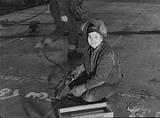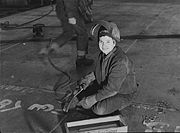
Richmond Shipyards
Encyclopedia
The four Richmond Shipyards, located in the city of Richmond, California
, United States
, were run by Permanente Metals
and part of the Kaiser Shipyards
, and were responsible for constructing more ships during World War II
than any other shipyard
in the country. The shipyards are part of the Rosie the Riveter/World War II Home Front National Historical Park
. The park's Rosie the Riveter
memorial is located on the former grounds of Shipyard #2. Shipyard #3 is listed on the National Register of Historic Places
.
Henry J. Kaiser
had been building cargo ship
s for the U.S. Maritime Commission in the late 1930s. When orders for ships from the British government, already at war with Nazi Germany
, allowed for growth, Kaiser established his first Richmond shipyard, beginning in December, 1940.
More than 747 vessels were built here in the four Richmond Kaiser Shipyards during World War II
; a feat not equaled anywhere else in the world, before or since. These ships were completed in two-thirds the amount of time and at a quarter of the cost of the average of all other shipyards. The Liberty ship
SS Robert E. Peary
was assembled in less than five days as a part of a special competition among shipyards; but by 1944 it was only taking the astonishingly brief time of a little over two weeks to assemble a Liberty ship by standard methods.
 Henry Kaiser and his workers applied mass assembly line
Henry Kaiser and his workers applied mass assembly line
techniques to building the ships. This production line technique, bringing pre-made parts together, moving them into place with huge cranes and having them welded together by "Rosies" (actually "Wendy the Welders" here in the shipyards), allowed unskilled laborers to do repetitive jobs requiring relatively little training to accomplish. This not only increased the speed of construction, but also the size of the mobilization effort, and in doing so, opened up jobs to women and minorities.
During WWII, thousands of men and women worked in this area every day, in very hazardous jobs. Actively recruited by Kaiser, they came from all over the United States to swell the population of Richmond from 20,000 to over 100,000 in three short years. For many of them, this was the first time they worked and earned money. It was the first time they were faced with the problems of being working parents -- finding day care
and housing. Women and minorities entered the workforce in areas previously denied to them. However, they still faced unequal pay, were shunted off into "auxiliary" unions and still had to deal with day-to-day prejudice and inequities. During the war, there were labor strikes and sit-down work stoppages that eventually led to better conditions.
Many workers commuted from other parts of the Bay Area to the Kaiser Shipyards in Richmond by way of the Shipyard Railway
, a temporary wartime railway which ran from a depot in Emeryville, California
to a loop line serving all four of the shipyards, and using cars of the local Key System
.
The SS Red Oak Victory
is docked nearby.
Richmond, California
Richmond is a city in western Contra Costa County, California, United States. The city was incorporated on August 7, 1905. It is located in the East Bay, part of the San Francisco Bay Area. It is a residential inner suburb of San Francisco, as well as the site of heavy industry, which has been...
, United States
United States
The United States of America is a federal constitutional republic comprising fifty states and a federal district...
, were run by Permanente Metals
Permanente Metals
Permanente Metals Company managed the Richmond Shipyards, owned by Henry J. Kaiser. These four of the Kaiser Shipyards were known for the construction of Liberty ships.The company was also a major producer of magnesium during World War II...
and part of the Kaiser Shipyards
Kaiser Shipyards
The Kaiser Shipyards were seven major shipbuilding yards located mostly on the U.S. west coast during World War II. They were owned by the Kaiser Shipbuilding Company, a creation of American industrialist Henry J...
, and were responsible for constructing more ships during World War II
World War II
World War II, or the Second World War , was a global conflict lasting from 1939 to 1945, involving most of the world's nations—including all of the great powers—eventually forming two opposing military alliances: the Allies and the Axis...
than any other shipyard
Shipyard
Shipyards and dockyards are places which repair and build ships. These can be yachts, military vessels, cruise liners or other cargo or passenger ships. Dockyards are sometimes more associated with maintenance and basing activities than shipyards, which are sometimes associated more with initial...
in the country. The shipyards are part of the Rosie the Riveter/World War II Home Front National Historical Park
Rosie the Riveter/World War II Home Front National Historical Park
Rosie the Riveter/World War II Home Front National Historical Park is located in Richmond, California, near San Francisco. The park encompasses an array of historic properties in the city which were constructed during the 1940s to support America's entry into World War II.The park is a "partnership...
. The park's Rosie the Riveter
Rosie the Riveter
Rosie the Riveter is a cultural icon of the United States, representing the American women who worked in factories during World War II, many of whom produced munitions and war supplies. These women sometimes took entirely new jobs replacing the male workers who were in the military...
memorial is located on the former grounds of Shipyard #2. Shipyard #3 is listed on the National Register of Historic Places
National Register of Historic Places
The National Register of Historic Places is the United States government's official list of districts, sites, buildings, structures, and objects deemed worthy of preservation...
.
Henry J. Kaiser
Henry J. Kaiser
Henry John Kaiser was an American industrialist who became known as the father of modern American shipbuilding. He established the Kaiser Shipyard which built Liberty ships during World War II, after which he formed Kaiser Aluminum and Kaiser Steel. Kaiser organized Kaiser Permanente health care...
had been building cargo ship
Cargo ship
A cargo ship or freighter is any sort of ship or vessel that carries cargo, goods, and materials from one port to another. Thousands of cargo carriers ply the world's seas and oceans each year; they handle the bulk of international trade...
s for the U.S. Maritime Commission in the late 1930s. When orders for ships from the British government, already at war with Nazi Germany
Nazi Germany
Nazi Germany , also known as the Third Reich , but officially called German Reich from 1933 to 1943 and Greater German Reich from 26 June 1943 onward, is the name commonly used to refer to the state of Germany from 1933 to 1945, when it was a totalitarian dictatorship ruled by...
, allowed for growth, Kaiser established his first Richmond shipyard, beginning in December, 1940.
More than 747 vessels were built here in the four Richmond Kaiser Shipyards during World War II
World War II
World War II, or the Second World War , was a global conflict lasting from 1939 to 1945, involving most of the world's nations—including all of the great powers—eventually forming two opposing military alliances: the Allies and the Axis...
; a feat not equaled anywhere else in the world, before or since. These ships were completed in two-thirds the amount of time and at a quarter of the cost of the average of all other shipyards. The Liberty ship
Liberty ship
Liberty ships were cargo ships built in the United States during World War II. Though British in conception, they were adapted by the U.S. as they were cheap and quick to build, and came to symbolize U.S. wartime industrial output. Based on vessels ordered by Britain to replace ships torpedoed by...
SS Robert E. Peary
SS Robert E. Peary
SS Robert E. Peary was a Liberty ship which gained fame during World War II for being built in a shorter time than any other such vessel. Named after Robert Peary, an American explorer who claimed to have been the first person to reach the geographic North Pole, she was launched on November 12,...
was assembled in less than five days as a part of a special competition among shipyards; but by 1944 it was only taking the astonishingly brief time of a little over two weeks to assemble a Liberty ship by standard methods.

Assembly line
An assembly line is a manufacturing process in which parts are added to a product in a sequential manner using optimally planned logistics to create a finished product much faster than with handcrafting-type methods...
techniques to building the ships. This production line technique, bringing pre-made parts together, moving them into place with huge cranes and having them welded together by "Rosies" (actually "Wendy the Welders" here in the shipyards), allowed unskilled laborers to do repetitive jobs requiring relatively little training to accomplish. This not only increased the speed of construction, but also the size of the mobilization effort, and in doing so, opened up jobs to women and minorities.
During WWII, thousands of men and women worked in this area every day, in very hazardous jobs. Actively recruited by Kaiser, they came from all over the United States to swell the population of Richmond from 20,000 to over 100,000 in three short years. For many of them, this was the first time they worked and earned money. It was the first time they were faced with the problems of being working parents -- finding day care
Day care
Child care or day care is care of a child during the day by a person other than the child's legal guardians, typically performed by someone outside the child's immediate family...
and housing. Women and minorities entered the workforce in areas previously denied to them. However, they still faced unequal pay, were shunted off into "auxiliary" unions and still had to deal with day-to-day prejudice and inequities. During the war, there were labor strikes and sit-down work stoppages that eventually led to better conditions.
Many workers commuted from other parts of the Bay Area to the Kaiser Shipyards in Richmond by way of the Shipyard Railway
Shipyard Railway
The Shipyard Railway was an electric railroad line, rapidly constructed during World War II to transport workers to and from the Kaiser Shipyards located in the city of Richmond, California....
, a temporary wartime railway which ran from a depot in Emeryville, California
Emeryville, California
Emeryville is a small city located in Alameda County, California, in the United States. It is located in a corridor between the cities of Berkeley and Oakland, extending to the shore of San Francisco Bay. Its proximity to San Francisco, the Bay Bridge, the University of California, Berkeley, and...
to a loop line serving all four of the shipyards, and using cars of the local Key System
Key System
The Key System was a privately owned company which provided mass transit in the cities of Oakland, Berkeley, Alameda, Emeryville, Piedmont, San Leandro, Richmond, Albany and El Cerrito in the eastern San Francisco Bay Area from 1903 until 1960, when the system was sold to a newly formed public...
.
The SS Red Oak Victory
SS Red Oak Victory (AK-235)
SS Red Oak Victory is a World War II Victory ship preserved as a museum ship in Richmond, California. It was one of 534 Victories built during World War II, but one of only a few of these ships to be transferred from the Merchant Marine to the United States Navy. It was named after Red Oak, Iowa,...
is docked nearby.
External links
- Images and oral history transcripts describing the early days of the Richmond Shipyards, via Calisphere, California Digital Library.
- Permanente Metals Corporation - Kaiser Richmond CA Shipyards

